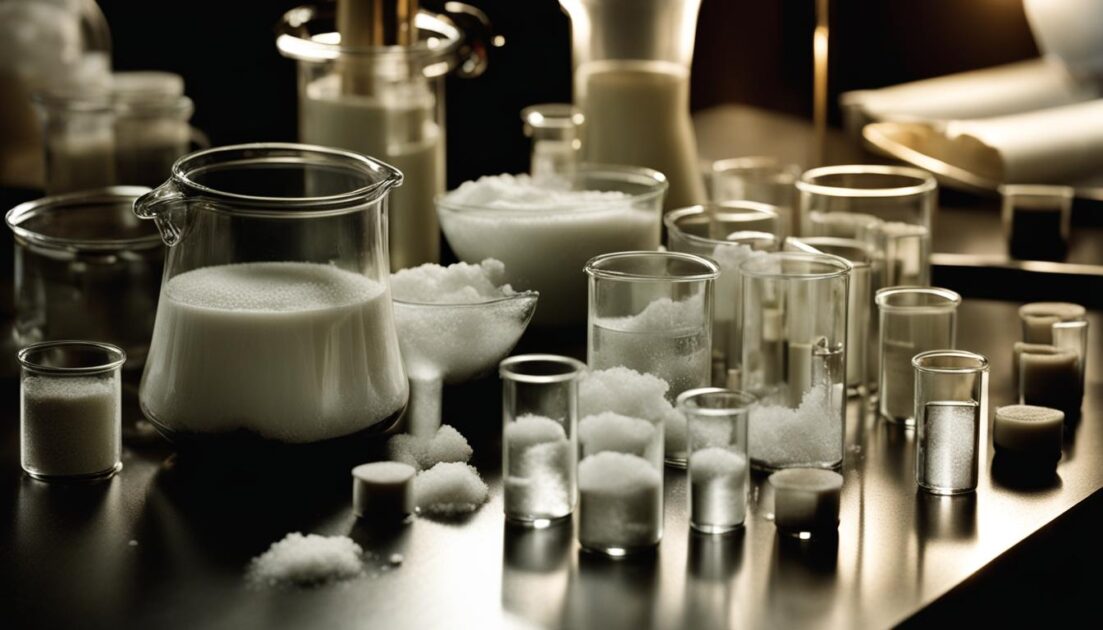Calcium phosphate is a calcium salt of phosphoric acid widely used in various industries such as biology, geology, industry, medicine, and dentistry. Its chemical formula, Ca3(PO4)2, makes it a versatile compound with diverse applications.
If you’re interested in learning how to make your own calcium phosphate, whether for educational purposes or practical use, this article will guide you through the process. Making calcium phosphate at home can be a rewarding DIY project that allows you to understand the production process and explore its properties.
Before diving into the recipe, it’s crucial to note that calcium phosphate, like any chemical compound, should be handled with caution. Proper safety precautions should be taken, and ingesting toxic doses of calcium phosphate or its nanoparticle form can be hazardous to health.
Key Takeaways:
- Calcium phosphate is a calcium salt of phosphoric acid with a wide range of applications.
- It is used in various industries, including biology, geology, industry, medicine, and dentistry.
- Caution should be exercised when handling calcium phosphate, as ingesting toxic doses or its nanoparticle form can be harmful.
- Stay tuned for step-by-step instructions on how to make your own calcium phosphate at home.
- Understanding the properties and uses of calcium phosphate can further enhance your knowledge of this versatile compound.
Preparation of Calcium Phosphate
When it comes to the production of calcium phosphate, there are a few key methods that can be employed. One common approach is the reaction between phosphoric acid (H3PO4) and solid calcium hydroxide (Ca(OH)2). This chemical reaction leads to the formation of calcium phosphate and water as byproducts. Another method involves using an aqueous solution of calcium hydroxide to produce dibasic calcium phosphate. By adding excess phosphoric acid to either a dibasic solution or a tribasic calcium phosphate solution and allowing the solution to evaporate, monobasic calcium phosphate can be obtained. Each of these methods results in calcium phosphate with distinct compositions and properties.
It’s important to note that the preparation of calcium phosphate requires careful handling and adherence to safety protocols. The use of appropriate equipment and precise measurements is crucial to ensure the accuracy and quality of the final product.
To better understand the process, let’s take a closer look at the chemical equation for the reaction between phosphoric acid and calcium hydroxide:
2 H3PO4 + 3 Ca(OH)2 → Ca3(PO4)2 + 6 H2O
This equation demonstrates the stoichiometric ratio needed to achieve the desired reaction and produce calcium phosphate. By following this equation, manufacturers can ensure consistent and reliable calcium phosphate production.
Now, let’s dive deeper into the properties and uses of calcium phosphate in the following section.
Properties and Uses of Calcium Phosphate
Calcium phosphate, with its molecular weight, density, boiling point, and melting point, possesses a range of properties that make it a versatile compound used in various industries. Its applications extend from veterinary medicine to food production, plastics, and manufacturing.
As an antacid and dietary supplement, calcium phosphate plays a crucial role in veterinary medicine. It is also utilized as a buffer in food, providing stability and enhancing the quality of certain products. Moreover, calcium phosphate serves as a stabilizer in plastics, ensuring their durability and strength.
In the manufacturing of milk glass, calcium phosphate is a key ingredient, contributing to the transparency and thickness of the final product. Additionally, it finds utility in the production of fertilizers, luminescent materials, dental powders, and the clarification of sugar syrups.
Calcium phosphate occurs naturally in bones, milk, teeth, and the ground, making it readily available for various purposes.
| Properties of Calcium Phosphate | Uses of Calcium Phosphate |
|---|---|
| Density | Antacid and dietary supplement in veterinary medicine |
| Melting point | Buffer in food |
| Boiling point | Stabilizer in plastics |
| Inherent health hazards | Manufacturing of milk glass |
| Production of fertilizers, luminescent materials, dental powders, and clarification of sugar syrups |

Understanding the diverse properties and applications of calcium phosphate is essential for ensuring its safe and effective utilization in various industries.
Calcium Phosphate Solubility and Structure
The solubility of calcium phosphate is a critical characteristic that influences its behavior in various reactions and biological processes. Solubility is influenced by factors such as pH, concentrations of acids and bases, and other environmental conditions. Understanding the solubility of calcium phosphate is essential for its successful application in different fields.
Calcium phosphate-based bone graft replacements, referred to as bioceramics, have gained popularity due to their excellent biocompatibility, biodegradability, and osteoconductivity. These materials provide a framework for new bone growth, aiding in the repair and regeneration of bones.
The structure of calcium phosphate, with the chemical formula Ca3(PO4)2, is composed of calcium and phosphate ions arranged in a specific pattern. The arrangement of these ions gives calcium phosphate its unique properties and stability.
“Calcium phosphate-based bone graft replacements provide a framework for new bone growth, aiding in the repair and regeneration of bones.”
Understanding the structure of calcium phosphate is crucial for designing and developing materials with tailored properties and applications. By manipulating the composition and arrangement of the calcium and phosphate ions, researchers can control factors such as porosity, surface area, and dissolution rates, enabling the customization of calcium phosphate materials for specific purposes.
For instance, in the field of biomaterials, the structure of calcium phosphate can be modified to enhance drug delivery, promote tissue regeneration, and improve the overall performance of implants. By comprehending the solubility and structure of calcium phosphate, scientists and engineers can advance materials that meet the diverse needs of various industries, including medicine, dentistry, and biotechnology.
Solubility of Calcium Phosphate
The solubility of calcium phosphate is influenced by its different phases and composition. There are several types of calcium phosphate compounds, including hydroxyapatite (HA), octacalcium phosphate (OCP), β-tricalcium phosphate (β-TCP), and α-tricalcium phosphate (α-TCP). Each compound has unique solubility characteristics.
“The solubility of calcium phosphate depends on various factors, such as pH, concentrations of acids and bases, and other environmental conditions.”
For example, hydroxyapatite, which is the main component of natural bone, has a relatively low solubility compared to other calcium phosphate compounds. This characteristic contributes to its stability and long-lasting presence in the bone tissue.
Different forms of calcium phosphate have distinct solubility properties, making them suitable for specific applications. Understanding the solubility of calcium phosphate compounds allows for better control over their performance in various physiological and chemical environments.
Structure of Calcium Phosphate
The structure of calcium phosphate determines its physical and chemical properties, making it an essential consideration in material design and development. The arrangement of calcium and phosphate ions in calcium phosphate compounds influences factors such as crystallinity, porosity, and bioactivity.
Calcium phosphate compounds have various crystal structures, including monoclinic, triclinic, and hexagonal. The three-dimensional arrangement of ions within the crystal lattice affects the material’s mechanical integrity, dissolution rates, and interaction with biological systems.
“The arrangement of calcium and phosphate ions in calcium phosphate compounds determines their unique properties and stability.”
One of the most common and well-known structures of calcium phosphate is hydroxyapatite. Hydroxyapatite crystals feature calcium ions layered between phosphate ion sheets, creating a strong and stable structure. This arrangement is similar to that found in natural bone, enhancing the biocompatibility and bone bonding capabilities of hydroxyapatite-based materials.
Table: Solubility of Calcium Phosphate Compounds
| Compound | Solubility |
|---|---|
| Hydroxyapatite | Low |
| Octacalcium phosphate | Medium |
| β-tricalcium phosphate | High |
| α-tricalcium phosphate | High |
Understanding the structure of calcium phosphate is crucial for harnessing its properties effectively. By tailoring the arrangement of calcium and phosphate ions, researchers can create materials with specific characteristics suited for diverse applications, ranging from biomedical implants to environmental remediation.

Water Soluble Calcium Phosphate in Natural Farming Practice
Water soluble calcium phosphate (WCP) is a valuable natural resource that can be easily made using grass-fed beef bones and organic fermented vinegar. To create WCP, the bones are first roasted to ensure they are clean and free of impurities. Then, they are carefully broken into small pieces and combined with the vinegar in a specific ratio.
After mixing, the bone and vinegar mixture should be allowed to sit undisturbed in a shaded area for several days. During this time, the bones will gradually dissolve, and the liquid will begin to separate from any solids. Once the bones are no longer moving or forming bubbles, the liquid can be considered water soluble calcium phosphate.
The next step is to strain the liquid to remove any remaining bone fragments. This can be done using a fine mesh strainer or cheesecloth. The resulting clear liquid should then be stored in a clean bottle or container. It is now ready to be used as a natural farming practice amendment.
Water soluble calcium phosphate can be applied to the roots and leaves of plants during different growth stages. This application helps strengthen the structure of plants, making them more resilient to infestations and diseases. Additionally, WCP can also be given to animals as a supplement to support their skeletal development.
FAQ
How do I make calcium phosphate at home?
You can make calcium phosphate at home by reacting phosphoric acid with solid calcium hydroxide or by using an aqueous solution of calcium hydroxide. There are different methods to produce calcium phosphate with varying compositions and properties.
What are the properties and uses of calcium phosphate?
Calcium phosphate has various properties, including molecular weight, density, boiling point, and melting point. It is used as an antacid, dietary supplement, buffer in food, stabilizer in plastics, and in the manufacturing of milk glass. Calcium phosphate also finds applications in fertilizers, dental powders, luminescent materials, and clarifying sugar syrups.
What is the solubility and structure of calcium phosphate?
The solubility of calcium phosphate depends on pH, concentrations of acids and bases, and other factors. It is important to understand the solubility and structure of calcium phosphate for its successful application in different fields. The structure of calcium phosphate consists of calcium and phosphate ions arranged in a specific pattern.
How can I make water-soluble calcium phosphate for natural farming practices?
Water-soluble calcium phosphate can be made using grass-fed beef bones and organic fermented vinegar. The bones are roasted, broken into small pieces, and combined with vinegar in a specific ratio. After several days of sitting in a shaded area, the liquid is strained and stored for use as a natural farming practice amendment. Water-soluble calcium phosphate strengthens plant structure and supports skeletal development in animals.






